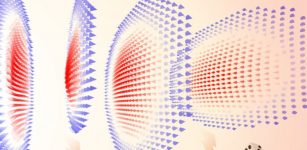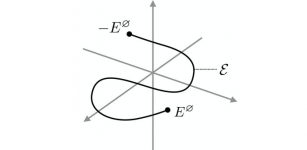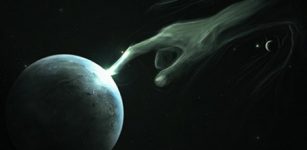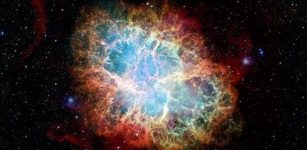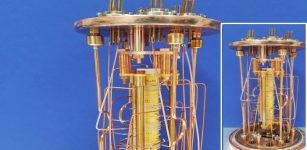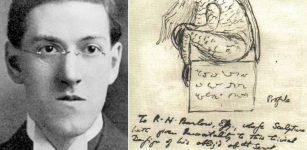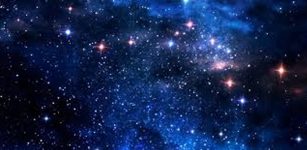New Theory Claims To Unite Einstein’s Gravity With Quantum Mechanics
Eddie Gonzales Jr. – MessageToEagle.com – A radical theory that consistently unifies gravity and quantum mechanics while preserving Einstein’s classical concept of spacetime is announced today in two papers published simultaneously by UCL physicists.
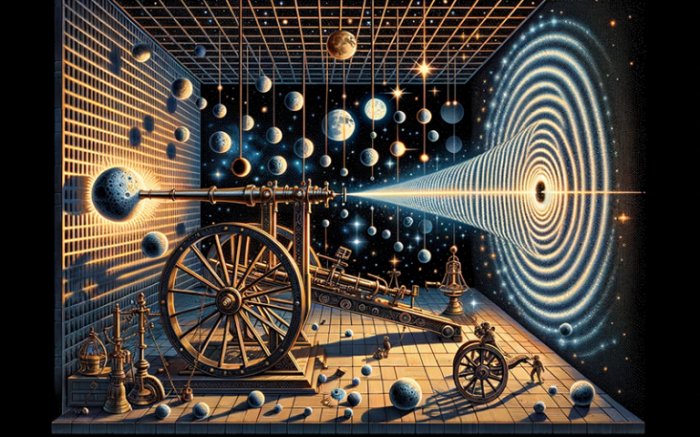 An Artistic version of Figure 1 in the PRX paper. It depicts an experiment in which heavy particles (illustrated as the moon) cause an interference pattern (a quantum effect), while also bending spacetime. The hanging pendulums depict the measurement of spacetime. The actual experiment is typically performed using Carbon-60, one of the largest known molecules. The UCL calculation indicates that the experiment should also be performed using higher density atoms such as gold. Credit: Isaac Young
An Artistic version of Figure 1 in the PRX paper. It depicts an experiment in which heavy particles (illustrated as the moon) cause an interference pattern (a quantum effect), while also bending spacetime. The hanging pendulums depict the measurement of spacetime. The actual experiment is typically performed using Carbon-60, one of the largest known molecules. The UCL calculation indicates that the experiment should also be performed using higher density atoms such as gold. Credit: Isaac Young
Modern physics is founded upon two pillars: quantum theory on the one hand, which governs the smallest particles in the universe, and Einstein’s theory of general relativity on the other, which explains gravity through the bending of spacetime. But these two theories are in contradiction with each other and a reconciliation has remained elusive for over a century.
The prevailing assumption has been that Einstein’s theory of gravity must be modified, or “quantised”, in order to fit within quantum theory. This is the approach of two leading candidates for a quantum theory of gravity, string theory and loop quantum gravity.
But a new theory, developed by Professor Jonathan Oppenheim (UCL Physics & Astronomy) and laid out in a new paper in Physical Review X (PRX), challenges that consensus and takes an alternative approach by suggesting that spacetime may be classical – that is, not governed by quantum theory at all.
Instead of modifying spacetime, the theory – dubbed a “postquantum theory of classical gravity” – modifies quantum theory and predicts an intrinsic breakdown in predictability that is mediated by spacetime itself. This results in random and violent fluctuations in spacetime that are larger than envisaged under quantum theory, rendering the apparent weight of objects unpredictable if measured precisely enough.
A second paper, published simultaneously in Nature Communications and led by Professor Oppenheim’s former PhD students, looks at some of the consequences of the theory, and proposes an experiment to test it: to measure a mass very precisely to see if its weight appears to fluctuate over time.
For example, the International Bureau of Weights and Measures in France routinely weigh a 1kg mass which used to be the 1kg standard. If the fluctuations in measurements of this 1kg mass are smaller than required for mathematical consistency, the theory can be ruled out.
The outcome of the experiment, or other evidence emerging which would confirm the quantum vs classical nature of spacetime, is the subject of a 5000:1 odds bet between Professor Oppenheim and Professor Carlo Rovelli and Dr Geoff Penington – leading proponents of quantum loop gravity and string theory respectively.
For the past five years, the UCL research group has been stress-testing the theory, and exploring its consequences.
Professor Oppenheim said: “Quantum theory and Einstein’s theory of general relativity are mathematically incompatible with each other, so it’s important to understand how this contradiction is resolved. Should spacetime be quantised, or should we modify quantum theory, or is it something else entirely? Now that we have a consistent fundamental theory in which spacetime does not get quantised, it’s anybody’s guess.”
Co-author Zach Weller-Davies, who as a PhD student at UCL helped develop the experimental proposal and made key contributions to the theory itself, said in a press release: “This discovery challenges our understanding of the fundamental nature of gravity but also offers avenues to probe its potential quantum nature.
The weighing of a mass—an experiment proposed by the UCL group which constrain any theory where spacetime is treated classically. Credit: Isaac Young
“We have shown that if spacetime doesn’t have a quantum nature, then there must be random fluctuations in the curvature of spacetime which have a particular signature that can be verified experimentally.
“In both quantum gravity and classical gravity, spacetime must be undergoing violent and random fluctuations all around us, but on a scale which we haven’t yet been able to detect. But if spacetime is classical, the fluctuations have to be larger than a certain scale, and this scale can be determined by another experiment where we test how long we can put a heavy atom in superposition* of being in two different locations.”
Co-authors Dr Carlo Sparaciari and Dr Barbara Šoda, whose analytical and numerical calculations helped guide the project, expressed hope that these experiments could determine whether the pursuit of a quantum theory of gravity is the right approach.
Dr Šoda (formerly UCL Physics & Astronomy, now at the Perimeter Institute of Theoretical Physics, Canada) said: “Because gravity is made manifest through the bending of space and time, we can think of the question in terms of whether the rate at which time flows has a quantum nature, or classical nature.
“And testing this is almost as simple as testing whether the weight of a mass is constant, or appears to fluctuate in a particular way.”
Dr Sparaciari (UCL Physics & Astronomy) said: “While the experimental concept is simple, the weighing of the object needs to be carried out with extreme precision.
“But what I find exciting is that starting from very general assumptions, we can prove a clear relationship between two measurable quantities – the scale of the spacetime fluctuations, and how long objects like atoms or apples can be put in quantum superposition of two different locations. We can then determine these two quantities experimentally.”
Weller-Davies added: “A delicate interplay must exist if quantum particles such as atoms are able to bend classical spacetime. There must be a fundamental trade-off between the wave nature of atoms, and how large the random fluctuations in spacetime need to be.”
The proposal to test whether spacetime is classical by looking for random fluctuations in mass is complementary to another experimental proposal which aims to verify the quantum nature of spacetime by looking for something called “gravitationally mediated entanglement.”
Professor Sougato Bose (UCL Physics & Astronomy), who was not involved with the announcement today, but was among those to first propose the entanglement experiment, said: “Experiments to test the nature of spacetime will take a large-scale effort, but they’re of huge importance from the perspective of understanding the fundamental laws of nature. I believe these experiments are within reach – these things are difficult to predict, but perhaps we’ll know the answer within the next 20 years.”
The postquantum theory has implications beyond gravity. The infamous and problematic “measurement postulate” of quantum theory is not needed, since quantum superpositions necessarily localise through their interaction with classical spacetime.
The theory was motivated by Professor Oppenheim’s attempt to resolve the black hole information problem. According to standard quantum theory, an object going into a black hole should be radiated back out in some way as information cannot be destroyed, but this violates general relativity, which says you can never know about objects that cross the black hole’s event horizon. The new theory allows for information to be destroyed, due to a fundamental breakdown in predictability.
Original story – University College London via Eurekalert
Written by Eddie Gonzales Jr. – MessageToEagle.com Staff Writer


